Canon EOS Ra
Table of Contents
- Pros vs. Cons Summary
- Red Halos and Workarounds
- WB Shift
- RF Mount
- Usability
- Sensor Performance
- Sample Images
- Raw Files
Pros vs. Cons Summary
Pros
- Drop-in filter system
- 30x zoom feature in live view
- White balance shift in firmware
- Only full frame mirrorless astrophotography camera (not 3rd party modded)
- Compatible with RF and EF lenses
- Touch autofocus on stars
- Good battery life
- Responsive, fully-articulating touch screen
Cons
- Fairly high price
- Red halos on bright stars that requires workaround
- Typical Canon banding that is worse at low ISOs
- No internal intervalometer
- Some questionable design choices (multi-touch bar)
Red Halos and Workaround
I first was made aware of a problem with red halos on bright stars from this thread on the Cloudy Nights forum. I soon found it was an issue with my Canon Ra as well, and looked for solutions. The first thing I tried was sending it to the Canon Service Center as my Canon EOS Ra was still under warranty. They replaced the entire sensor stack (CMOS Assembly) with a new one, and the red halos were still there. A helpful commenter on one of my YouTube videos let me know that the April 2020 issue of Tenmon Guide (pgs. 40-41) had reported on the issue, and identified it was likely a problem with the camera's extended near Infrared reponse. I took this information and tried an Astronomik L2 Clip-in filter. This filter has fixed the red halos while passing the Ha/SII emission lines very well (see below). I can see from more testing that ANY filter that blocks the near IR (700nm+) will also work to supress the red halos.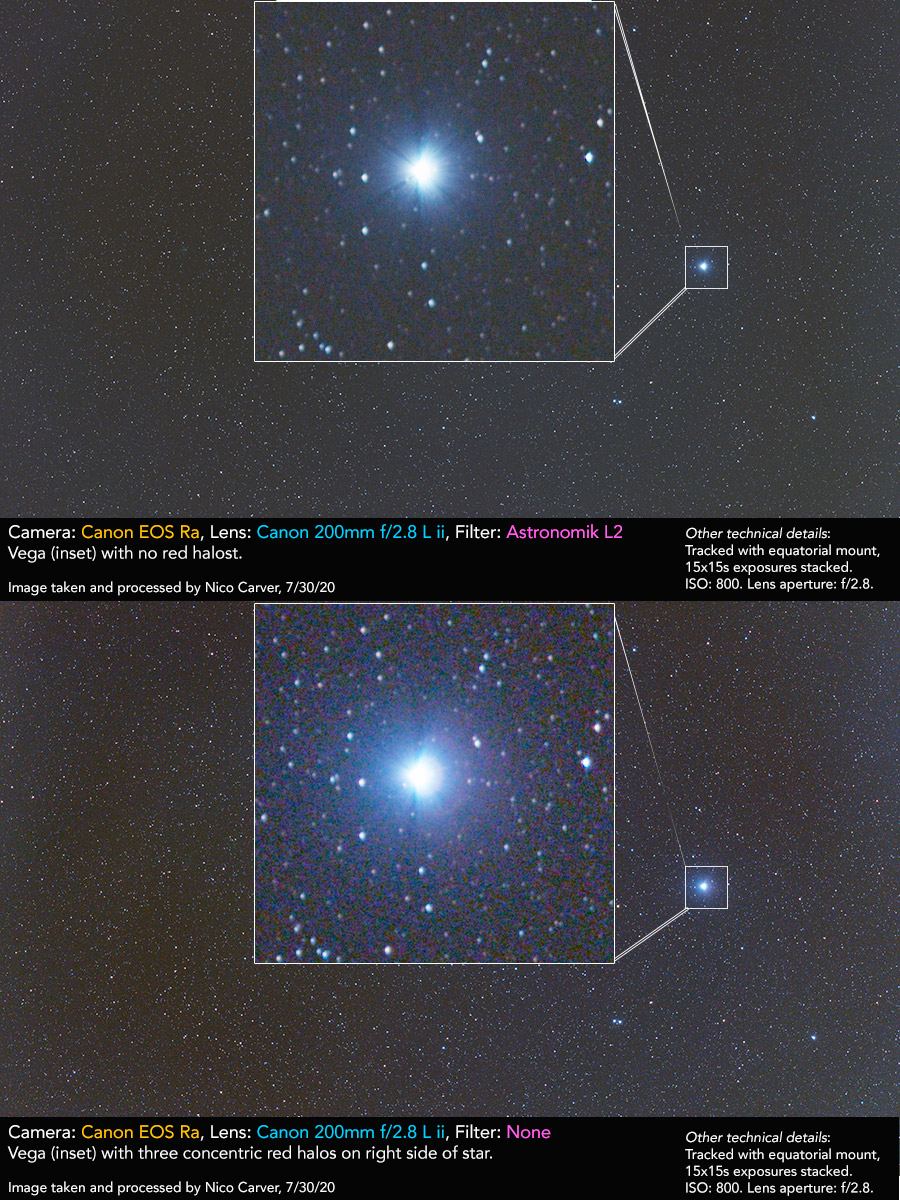
For my first few months of using the L2 clip-in filter it seemed to work well with every telescope and camera lens I tried it with. Unfortunately, I have just discovered a lens that definitely did not work with the Ra when I used any clip-in filter: the Sigma 14mm f/1.8 Art lens. The image quality was terrible away from center with streaked, out-of-focus stars whenever the filter was installed, and perfect stars with no filter. This has made me aware that I likely need to do more rigorous testing on the effect of the L2 clip-in filter. I will update the review here as I find out more.
Known lenses that will NOT work with the Astronomik L2 workaround
- Sigma 14mm f/1.8 Art
WB Shift
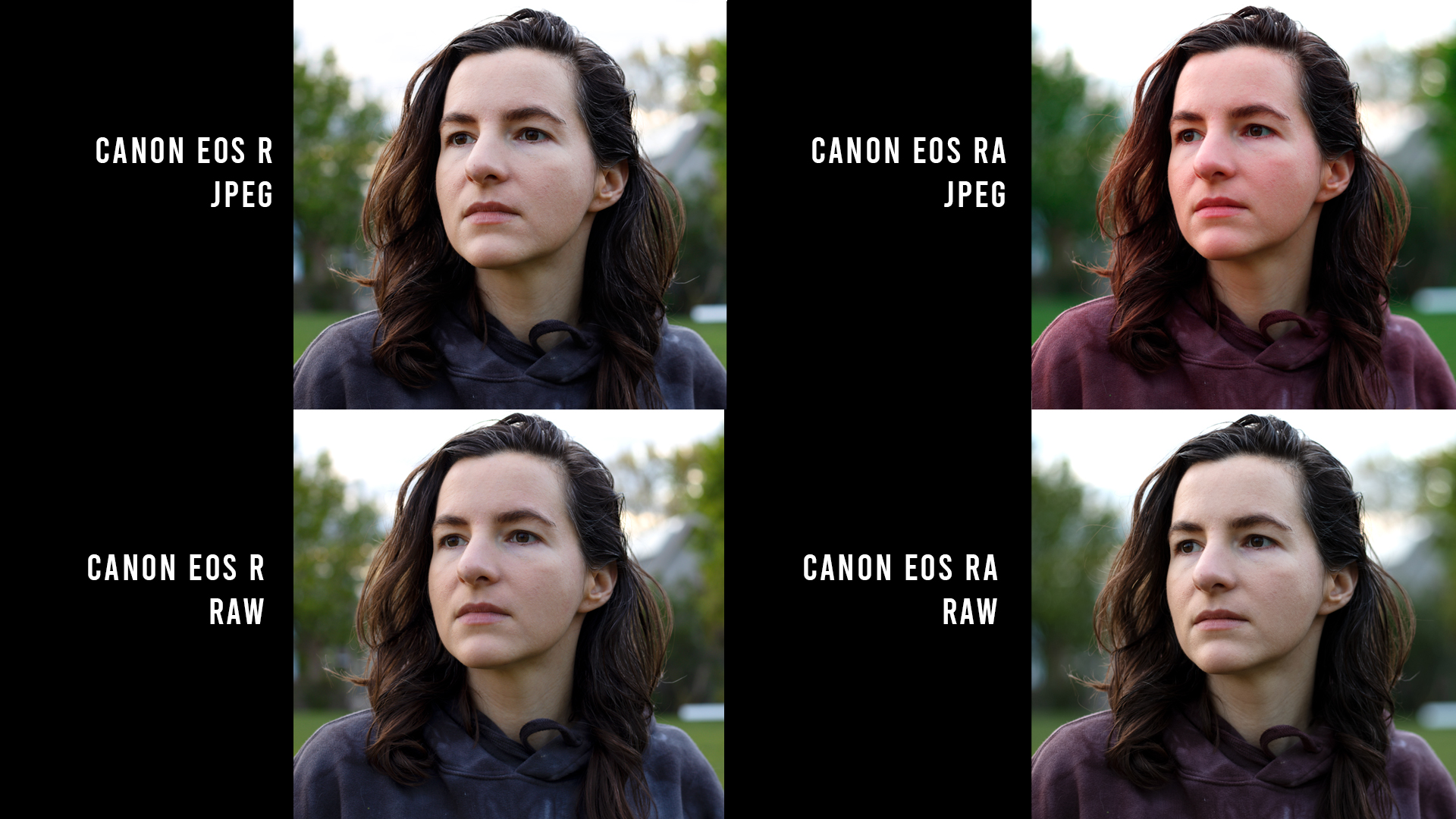
The big takeaway here is that the Ra shifts the white balance in firmware to look fairly 'natural' when you shoot in raw. This means you typically don't have to use a custom white balance with a gray card. It also means an OWB (original white balance) filter cannot be used, as there is no way to turn OFF the white balance shift. In fact, it is an undocumented feature as far as I can tell. The JPEG representation is not as bad as a 3rd-party modded camera, but comes out very saturated, esp. in the reds. The JPEG look is what you see in liveview and in playback so the camera cannot be used for color-critical work. The worst culprits in JPEG or raw are: dark clothing, dark scenes in general, sunsets, and flowers. That said, for many scenes, I found very little difference between the raw output of the R and the Ra due to the white balance shift in firmware. See a few comparisons below:
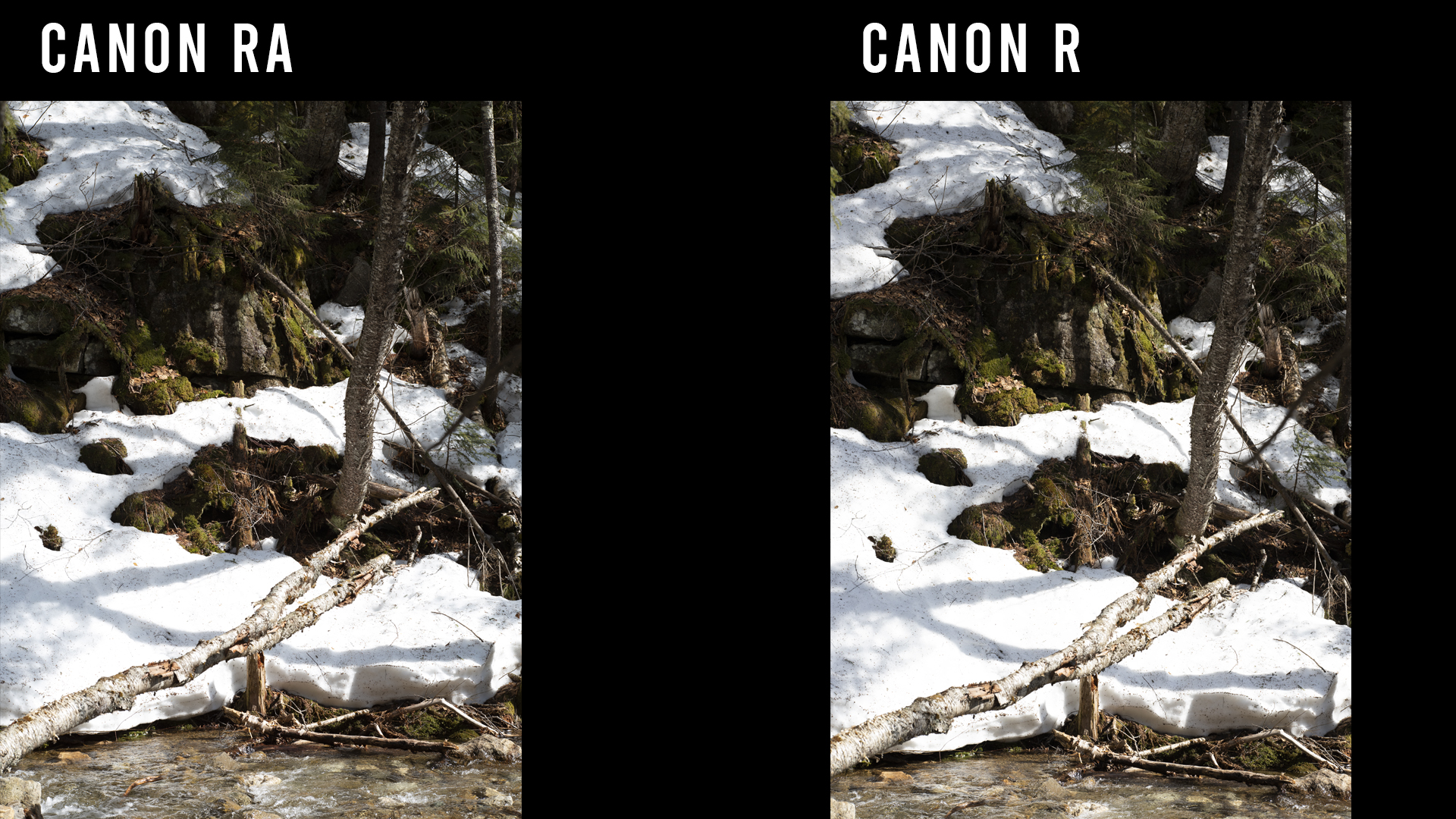
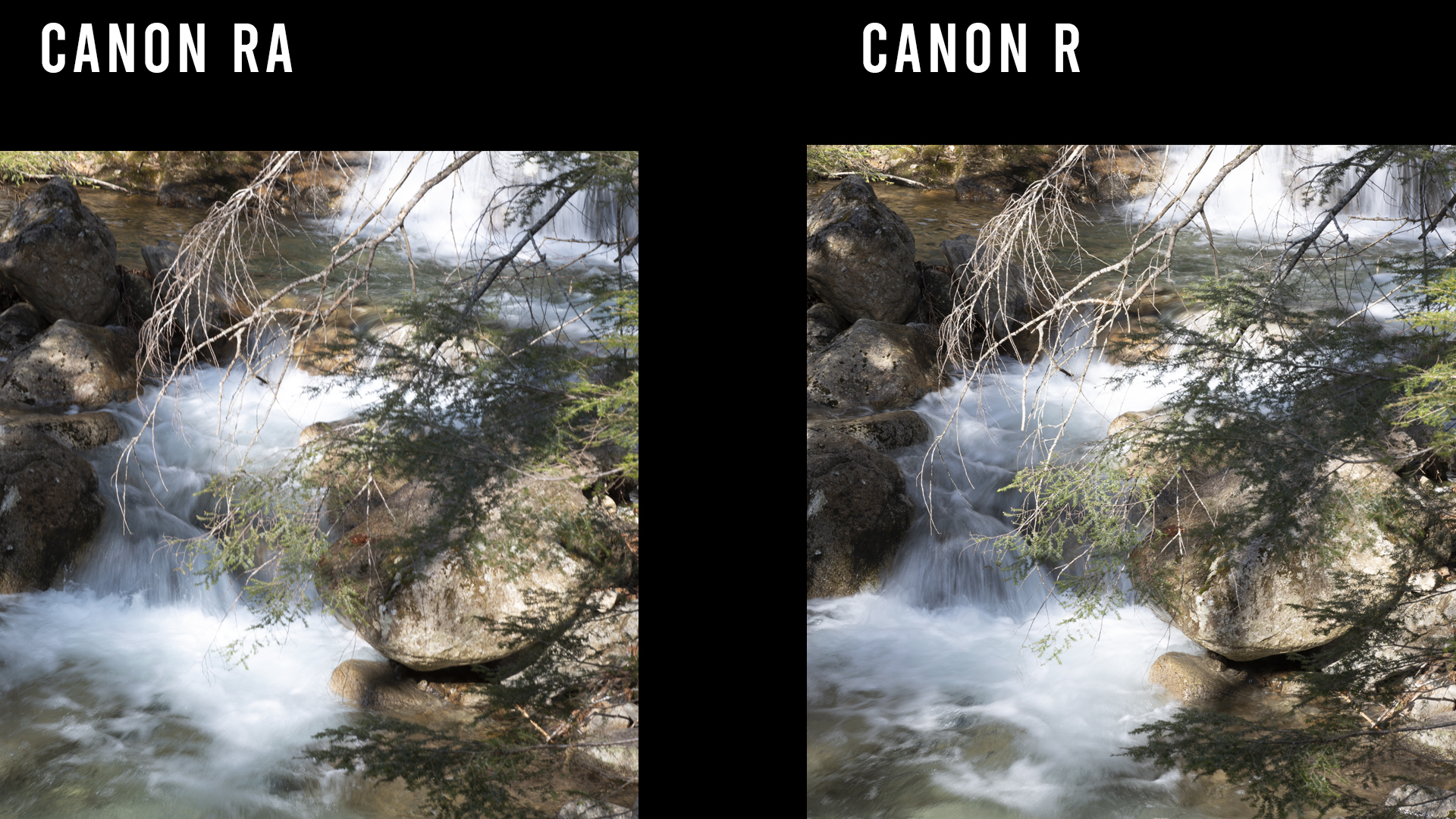
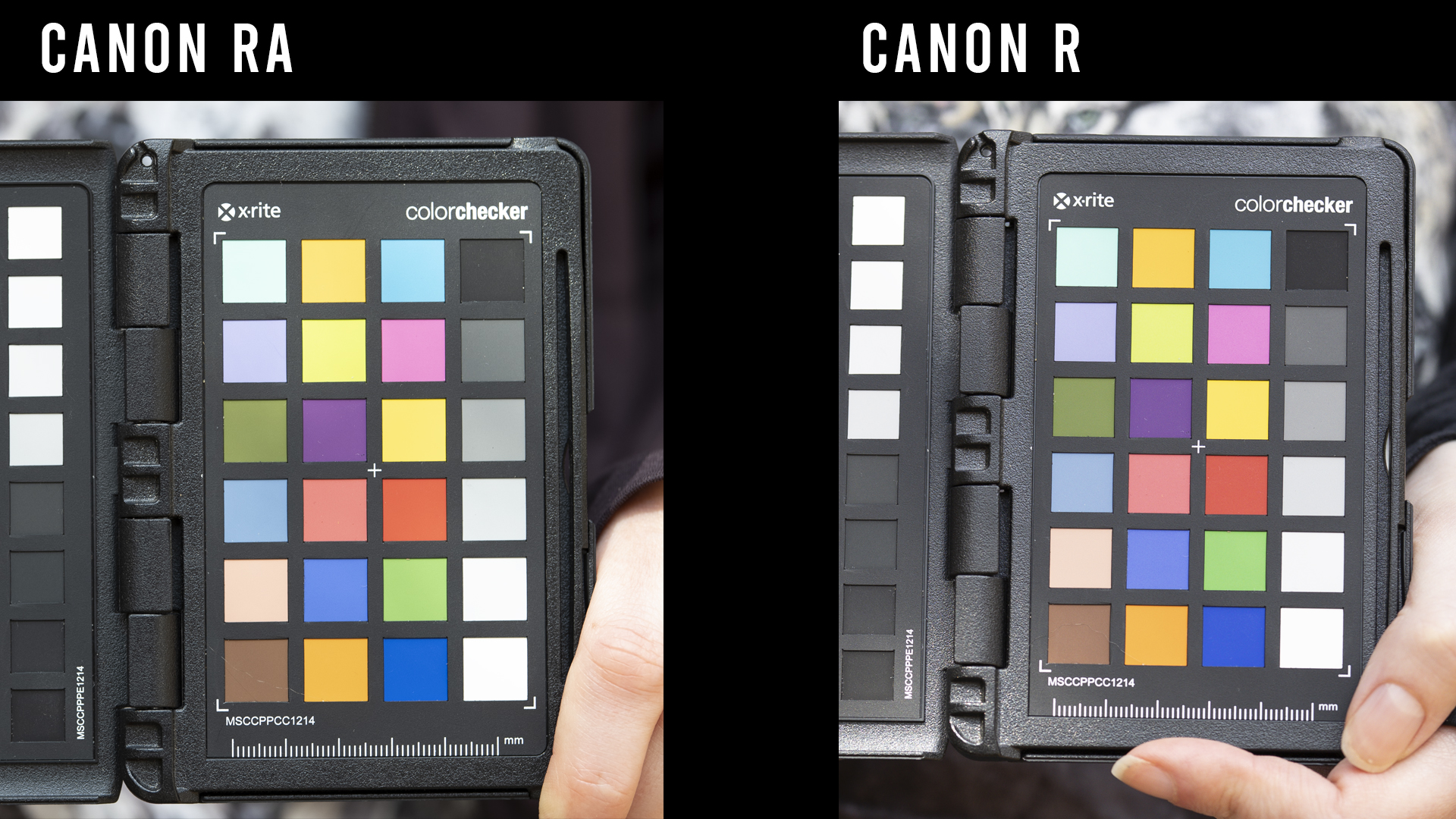
RF Mount
The RF mount and RF lenses is the future of development at Canon. In fact, there are no new EF mount lens announcements lately, and many EF lenses are starting to be discontinued. The shorter focal flange distance of the RF mount (20mm) opens up the possibility for new lens designs, and I was very impressed by the RF 85mm f/1.2 which I rented and used with the Canon Ra for 1 week. Here's an example of the image quality in a single JPEG image with this combination:
The shorter focal flange distance also allows for 24mm of usable space between EF lenses and the camera body. I have already started experimenting with using this to mount 2" filters in between the lens and camera with Canon's official drop-in filter adapter. 3d printed parts are available here to adapt your own 2" filters to the system. Hutech also sells IDAS filters pre-adapted to fit the Canon adapter. I have purchased and can recommend the NB2 and the Clear filter.
Usability
I had used Canon’s touch screens in newer rebel models like the t6i so I knew I liked them, but the Ra’s screen is even better than I expected. It’s very responsive, the UI makes sense, Its fully articulating which is great for astrophotography when you are often pointed up at the sky. In general, between the flip out screen, and the little settings screen on top and the normal buttons and dials, I find it a joy to use once I got where the functions are located in to my muscle memory.There is a little multi-function bar to the right of the viewfinder here that didn’t work for me. I found my thumb was too big and I was constantly just accidentally touching it. So I turned that off completely, which I’m glad you can do in the menus. In fact you can do a lot of customizations of how the camera buttons and dials work through the menus. That said, I think overall the menu design is just okay. I think Canon really missed the mark by not adding any additional menu features or options for the Ra over the R. For example, there is no internal interval timer. It would make so much sense for the Ra to have an internal interval timer that would have no limit on exposure length in bulb mode. The Ra does have an internal bulb timer, but it can only be used to take one photo at a time. What I need as a deep sky astrophotographer is a way to program a sequence of long exposures. So I end up using a tethered computer and software to do this or even more often a simple external intervalometer remote to do this, but using either a computer or an intervalometer is a single point of failure that Canon could have avoided by just including this in the menu. Another missed opportunity, is there is a buried option in Custom Function menu 5 called “Release shutter w/o lens” when you buy the Ra this function is set to OFF. meaning you can’t take a photo unless connected to a lens providing electronic communication to the camera. This is really stupid for an astro camera. They should have this setting turned to ON by default so the new user of this camera doesn’t connect to a telescope and think their Ra is broken because it won’t take a picture.
One cool thing Canon did add to the Ra firmware is a 30x zoom in live view. This can be really handy for zooming way in and focusing on the small stars even with very wide angle lenses. I’ve now been out several nights with the R and the Ra side by side and with wide angle lenses it’s much easier to focus on the Ra as I can actually see the stars. Now, even this implementation was not as perfect as I’d like. The R goes 5x and then 10x zoom, The Ra goes 5x and then 30x. But there is no option on the Ra to ever get 10x. This makes it more difficult to focus manually on landscape features, and I’ve talked to landscape astrophotograpers who desperately want it to go 5x 10x then 30x. Or at least for that to be an option you can enable.
Another interesting aspect is autofocusing on the stars with fast lenses at dark sites. This is not something unique to the Ra perhaps, but it was new to me and I was pretty amazed to find if you tap a bright star on the screen, any fast lens seems to do a good job now of quickly finding autofocus if there is plenty of contrast with a nice dark sky. What I have done several times now is tap a bright star with the autofocus on, the camera focuses and takes a photo, I then check the photo in playback mode, and if it looks good. I just carefully switch the lens back to manual focus and it will retain that focus position. This is a really easy way to focus when it works. It’s not a fool-proof method, but between this tap autofocus and the 30x zoom, I’ve never had a better time focusing with wide angle lenses, which is a big deal for me. Because wide angle lenses just don’t work very well with a bahtinov mask since the stars are so small, it’s very hard if not impossible to see the diffraction pattern.
Canon has continued to update their LP-E6 style battery of which I have many. The newer ones are the LP-E6N, but the Ra can also use the older LP-E6. The difference is just a small change in capacity from 1800 mAh for the old batteries to 1865 mAh with the new N versions. Astrophotography is interesting in terms of battery conversations because so much of the time when doing astrophotography we are shooting long exposures and the screen turns off while taking an exposure. This can dramatically increase battery life as the always-on screen is a major drain with mirrorless cameras. On this note, I also turn down screen brightness all the way, which is in the menu. And with these two things combined. I find that if I start the night with a fully charged battery, I’ll still have a bit left at the end of a good 6-7 hour night of shooting.
Sensor Performance
The Ra is thought to be basically the same sensor that Canon used in the Canon 5D mark 4, but of course the Ra has a different filter stack in front of that sensor. Canon has always lagged behind Sony and Nikon in terms of ISO invariance. We can look at ISO invariance by plotting the read noise in electrons of various camera models on Bill Claff’s excellent website Photon to Photos. If we compare the Canon R to the Ra, you can see the Ra does slightly better. I’m not sure exactly how to account for that, but I did send Bill Claff some data from my Ra to check and he said it was consistent with the other Ra he tested which you can see has better noise performance than the R. Another comparison on here I think it’s worth making is to the Nikon D810A which is Nikon’s last astrophotography camera and the last full frame astro interchangeable lens camera before the Ra. It’s still considered a legendary camera for what it’s capable of and as you can see the Ra is besting it in terms of read noise figures from ISO 400 onwards. If we look at modern Nikon mirrorless like the Z6, you can see the Ra is holding its’ own, but if we go to top of the line Nikon Z7, that is definitiely a very low noise camera. I should also say this does NOT tell you the whole picture of how these cameras perform, as fixed pattern noise, unadvertised raw noise reduction, and banding can be issues with many cameras. A lot of times the best question is: how well does any fixed pattern noise and banding calibrate out when using bias, darks, and flats? I can say with the Ra, calibration does a pretty good job, but I have noticed increase banding at lower ISOs. So I typically use the Ra at a minimum of ISO800. If I don’t dither and I’m subtracting heavy light pollution from an image, the fixed pattern noise can definitely be bad, but that’s true of any camera I’ve tested. From a dark site with reasonable amount of signal, I think the Canon Ra really shines and banding shouldn’t be a big issue, at least not any more than any other modern Canon camera.Sample Images






